Here is an extensible formula that can generate all combinations from an array input of up to five columns.
Caveats:
- It requires Excel 2019 or Excel 365
- It does not take columns as inputs - it takes an array, so you must size the input array to fit the columns that you want. (pls see notes below)
- While it does not rely on volatile functions, it is still computationally intensive and can run slow.
- You must have a minimum of 2 columns in your range and a maximum of 5.
- No column in the array can be completely blank.
In this example, I am taking an array of text cells in the range A1:E5 and I will combine them with a delimiter of " ". The formula uses LET to make it more efficient and readable. You can copy paste it into your destination cell - the formatting is only there to make it readable:
=LET( matrix, A1:E5,
d, " ",
cC, COLUMNS( matrix ), cSeq, SEQUENCE( 1, cC ),
rC, ROWS( matrix ), rSeq, SEQUENCE( rC ),
eC, rC ^ cC, eSeq, SEQUENCE( eC,,0 ),
m, INDEX( matrix, MOD( INT( INT( SEQUENCE( eC, cC, 0 )/cC )/rC^SEQUENCE( 1, cC, cC-1, -1 ) ), rC ) + 1, cSeq ),
n, INDEX( m, eSeq+1, cSeq ) <> 0,
r, IFERROR(INDEX( m, eSeq + 1, 1 ), "") &d& INDEX( m, eSeq + 1, 2 ) &d& IFERROR(INDEX( m, eSeq + 1, 3 ), "") &d&
IFERROR(INDEX( m, eSeq + 1, 4 ), "") &d& IFERROR(INDEX( m, eSeq + 1, 5 ), ""),
o, IFERROR( INDEX( r, eSeq+1, ), n ),
FILTER( INDEX( o, , 1), INDEX( n, , 1 ) * INDEX( n, , 2 ) * IFERROR(INDEX( n, , 3 ), TRUE) *
IFERROR(INDEX( n, , 4 ), TRUE) * IFERROR(INDEX( n, , 5 ), TRUE) ) )
Set the variable matrix to the range that you want. It is currently set to A1:E5. Set the d variable to the delimiter that you want to use. It is set to " " or space right now. Here is an example of the output:

Notes
I have another version that will take columns, but it is failing and I won't have time to debug it, so I thought it would be better to give you something for now that you might be able to adapt to your needs. The other version is also computationally faster. When I have debugged it, I will post it here.
This is extensible. If you want it to go to 6, 7, or more columns, it can be pretty easily modified. I chose not to do that because each column that it processes (even if there are no data in the column) slows down the calculation because of the design that I used. To extend it, you need to edit two lines near the end:
- You have to edit the variable r. You need to append another
&d&IFERROR(INDEX(m,eSeq+1, XXX ),"") in front of the comma where XXX is the next column. For example 6 and then 7, etc.
- You have to edit the final result that starts with FILTER. You need to append another
*IFERROR(INDEX(n,, XXX ),TRUE) in front of the last two close parens where XXX is the next column. For example 6 and then 7, etc.
Here is an example of a 7 column version:
=LET( matrix, A1:G5,
d, " ",
cC, COLUMNS( matrix ), cSeq, SEQUENCE( 1, cC ),
rC, ROWS( matrix ), rSeq, SEQUENCE( rC ),
eC, rC ^ cC, eSeq, SEQUENCE( eC,,0 ),
m, INDEX( matrix, MOD( INT( INT( SEQUENCE( eC, cC, 0 )/cC )/rC^SEQUENCE( 1, cC, cC-1, -1 ) ), rC ) + 1, cSeq ),
n, INDEX( m, eSeq+1, cSeq ) <> 0,
r, IFERROR(INDEX( m, eSeq + 1, 1 ), "") &d& INDEX( m, eSeq + 1, 2 ) &d& IFERROR(INDEX( m, eSeq + 1, 3 ), "") &d&
IFERROR(INDEX( m, eSeq + 1, 4 ), "") &d& IFERROR(INDEX( m, eSeq + 1, 5 ), "") &d& IFERROR(INDEX( m, eSeq + 1, 6 ), "") &d& IFERROR(INDEX( m, eSeq + 1, 7 ), ""),
o, IFERROR( INDEX( r, eSeq+1, ), n ),
FILTER( INDEX( o, , 1), INDEX( n, , 1 ) * INDEX( n, , 2 ) * IFERROR(INDEX( n, , 3 ), TRUE) *
IFERROR(INDEX( n, , 4 ), TRUE) * IFERROR(INDEX( n, , 5 ), TRUE) * IFERROR(INDEX( n, , 6 ), TRUE) * IFERROR(INDEX( n, , 7 ), TRUE) ) )
